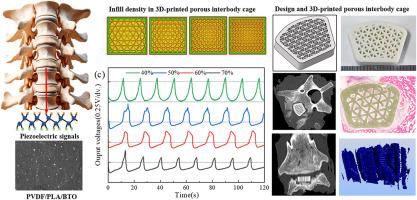Innovative 3D-printed porous piezoelectric poly(vinylidene fluoride) cages with accelerated spinal fusion
IF 10.2
1区 医学
Q1 ENGINEERING, BIOMEDICAL
引用次数: 0
Abstract
Spinal fusion is an efficient treatment for degenerative disc disease, however, poor osseointegration capacity of spinal cages often cause clinical implant failure. Herein, we proposed an innovative piezoelectric interbody fusion cage with porous structure, load-carrying capacity and enhanced osseointegration effect via 3D printing technology. Firstly, poly(vinylidene fluoride) (PVDF), poly(lactic acid) PLA and ceramic barium titanate (BTO) were compounded to prepare the composite filament with improved 3D printability and good piezoelectric effect. It is found that both BTO and PLA are favored for β-phase transformation and PLA effectively solves the warping issue during the 3D-printing. Then, cages with triangular lattice with varying infill densities are designed and fabricated. It is found that triangular PVDF/PLA/BTO structure with lower infill density exhibits stronger piezoelectric effect, and all the samples exhibited compressive properties analogous to trabecular bone. Furthermore, the in vitro cellular assays and in vivo large animal model sheep experiments validated an obvious piezoelectric effect on osseointegration for PVDF/PLA/BTO cages. After three-month implantation, it presented promoted new bone formation with a bone volume of 76.8 % in contrast with that of 49.3 % in PEEK counterpart. Therefore, the current study highlights a promising material for intervertebral fusion cages with good biomimetic mechanical performance and spinal osseointegration effect.

创新的3d打印多孔压电聚偏氟乙烯(偏氟乙烯)笼子,加速脊柱融合
脊柱融合术是治疗退行性椎间盘疾病的有效方法,但脊柱笼骨融合能力差往往导致临床植入失败。本文采用3D打印技术,提出了一种具有多孔结构、承载能力和增强骨融合效果的新型压电体间融合器。首先,将聚偏氟乙烯(PVDF)、聚乳酸(PLA)和陶瓷钛酸钡(BTO)进行复配,制备出3D打印性能提高、压电效果好的复合长丝;研究发现,BTO和PLA都有利于β相变,PLA有效地解决了3d打印过程中的翘曲问题。然后,设计和制造了具有不同填充密度的三角形格子笼。研究发现,填充密度较低的三角形PVDF/PLA/BTO结构具有较强的压电效应,且所有样品都具有类似小梁骨的压缩性能。此外,体外细胞实验和大型动物模型羊体内实验验证了PVDF/PLA/BTO笼对骨整合的明显压电效应。植入3个月后,促进新骨形成,骨体积为76.8%,而PEEK的骨体积为49.3%。因此,目前的研究重点是一种具有良好仿生力学性能和脊柱骨融合效果的椎间融合笼材料。
本文章由计算机程序翻译,如有差异,请以英文原文为准。
求助全文
约1分钟内获得全文
求助全文
来源期刊

Materials Today Bio
Multiple-
CiteScore
8.30
自引率
4.90%
发文量
303
审稿时长
30 days
期刊介绍:
Materials Today Bio is a multidisciplinary journal that specializes in the intersection between biology and materials science, chemistry, physics, engineering, and medicine. It covers various aspects such as the design and assembly of new structures, their interaction with biological systems, functionalization, bioimaging, therapies, and diagnostics in healthcare. The journal aims to showcase the most significant advancements and discoveries in this field. As part of the Materials Today family, Materials Today Bio provides rigorous peer review, quick decision-making, and high visibility for authors. It is indexed in Scopus, PubMed Central, Emerging Sources, Citation Index (ESCI), and Directory of Open Access Journals (DOAJ).
 求助内容:
求助内容: 应助结果提醒方式:
应助结果提醒方式:


